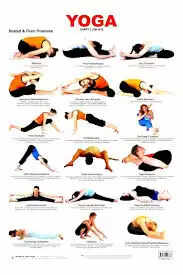Know More About Names Of Yoga Poses

There are numerous great reasons to incorporate yoga into your exercise regimen. Yoga enhances muscle tone, flexibility, and balance, and it aids in relaxation and stress reduction, partly due to its distinctive pranayama breathing. Bonus: Studies have additionally shown that yogic practices alleviate stress, anxiety, depression, and chronic pain; help improve sleep; and elevate overall well-being and life quality.

1. Simple Pose — Sukhasana — to Alleviate Stress
Sit cross-legged on mat specially a yoga mat with your palms upward and hands on your knees. Maintain your spine as straight as possible. Press the bones you’re seated on down into the floor — your “sit bones” in yoga terminology. Close your eyes and inhale deeply.
“This is a wonderful pose for beginners to use as an evaluation,” says Gwen Lawrence, yoga coach for various sports teams, athletes, and celebrities.
2. Cat-Cow to Activate the Spine and Ease Back Pain
Position in a mat on all fours with hands directly underneath your shoulders and knees directly under your hips. Allocate your weight likewise between your hands as well as spread your fingers wide. Inhale and arch your back, rounding it upward as you lower your chin to your chest; feel the stretch from your neck to your tailbone, resembling a cat. As you exhale, lower your back down fully to a scoop shape as you lift your head, and tilt it backward.
“Cat-Cow stretches and activates the spine, which helps ease back pain,” says Leah Cullis, a certified yoga instructor and co-author of Power Yoga: Strength, Spirit, Sweat. It also increases the flexibility of the entire spine, chest neck, and shoulders. Repeat 5 to 10 times.
3. Tree Pose — Vrksasana — to Enhance Your Balance
Begin by standing upright for this pose. Bring your hands together in the prayer position and raise them above your head. Balance on right leg. Bend left knee outside to its left side and hold left foot to the inward thigh of right leg, or ankle. (To prevent injury, however, never press foot into your knee.) Hold it for thirty seconds. Switch your legs and continue.
4. Downward-Facing Dog — Adho Mukha Svanasana — to Increase Flexibility
In Downward-Facing Dog, the body makes the shape of an inverted V-shape. Begin by placing both hands on the mat in front of you, palms downward; your hands should be slightly in front of your shoulders. Put your knees on the ground straight under hips. Exhale as you try to lift your knees on the ground and lift buttocks as well as hips toward the up. Push the topmost of your thighs back & stretch your own heels down toward the mat. Put your head down in between your upper arms and in line rather than hanging down. If your lower backi is rounding, you try to bend your knees to assist extend it.
This yoga calms the whole nervous system, unzips the spine, works on total flexibility, fully tones the arms and opens the shoulders.
5. Child’s Pose — Balasana — to Help You Relax and Unwind
From Downward-Facing Dog, simply bend your knees and lower your buttocks to your heels as you bring your chest toward the floor over your knees. Lower your shoulders and head onto the ground. Put your palms down and arms along your sides, or you can just support your head by just folding your arms under forehead.
This yoga gives an opportunity to get grounded, go inward, and to come out of your hectic mind and into your body by awakening your breath from the inside out.” Child’s Pose is an excellent way to take a pause and relax during your yoga routine, or anytime you feel fatigued or overwhelmed.

